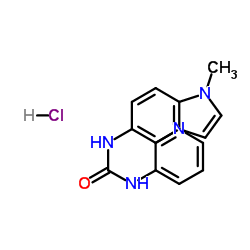143797-62-0
| Name | N-(1-Methyl-1H-5-indolyl)-N'-(3-pyridinyl)urea hydrochloride |
|---|---|
| Synonyms |
1-(1-Methyl-1H-indol-5-yl)-3-(3-pyridinyl)urea hydrochloride (1:1)
Urea, N-(1-methyl-1H-indol-5-yl)-N'-3-pyridinyl-, hydrochloride (1:1) 1-(1-Methyl-1H-indol-5-yl)-3-pyridin-3-ylurea hydrochloride (1:1) N-(1-Methyl-1H-5-indolyl)-N'-(3-pyridinyl)urea hydrochloride |
| Description | SB-200646A is the first selective 5-HT2B/2C over 5-HT2A receptor antagonist with pKi values of 7.5, 6.9 and 5.2 for 5-HT2B, 5-HT2C and 5-HT2A, respectively. SB-200646A is orally active and has electrophysiological and anxiolytic properties in vivo[1][2]. |
|---|---|
| Related Catalog | |
| Target |
5-HT2B Receptor:7.5 (pKi) 5-HT2C Receptor:6.9 (pKi) 5-HT2A Receptor:5.2 (pKi) |
| In Vitro | SB200646A (4 μM) abolishes the ethanol-induced increase in miniature inhibitory postsynaptic current (mIPSC) frequency and had no effect on basal mIPSC frequency[1]. |
| In Vivo | SB-200646A (20 mg/kg; intravenous injection; daily; for 21 days; male albino Sprague-Dawley rats) treatment significantly decreases the number of spontaneously active ventral tegmental area (VTA) dopaminergic neurons[1]. The i.v. administration of 4-16 mg/kg of SB-200646A significantly increases the firing rate and % events as bursts in spontaneously active VTA dopaminergic neurons and significantly increases the % events as burst in substantia nigra pars compacta (SNC) dopaminergic neurons[1]. Animal Model: Male albino Sprague-Dawley rats (200-225 g at the beginning of treatment and 300-350 g at the time of the experiment)[1] Dosage: 20 mg/kg Administration: Intravenous injection; daily; for 21 days Result: Significantly decreased the number of spontaneously active ventral tegmental area (VTA) dopaminergic neurons. |
| References |
| Molecular Formula | C15H15ClN4O |
|---|---|
| Molecular Weight | 302.759 |
| Exact Mass | 302.093445 |
| Storage condition | 2-8°C |
